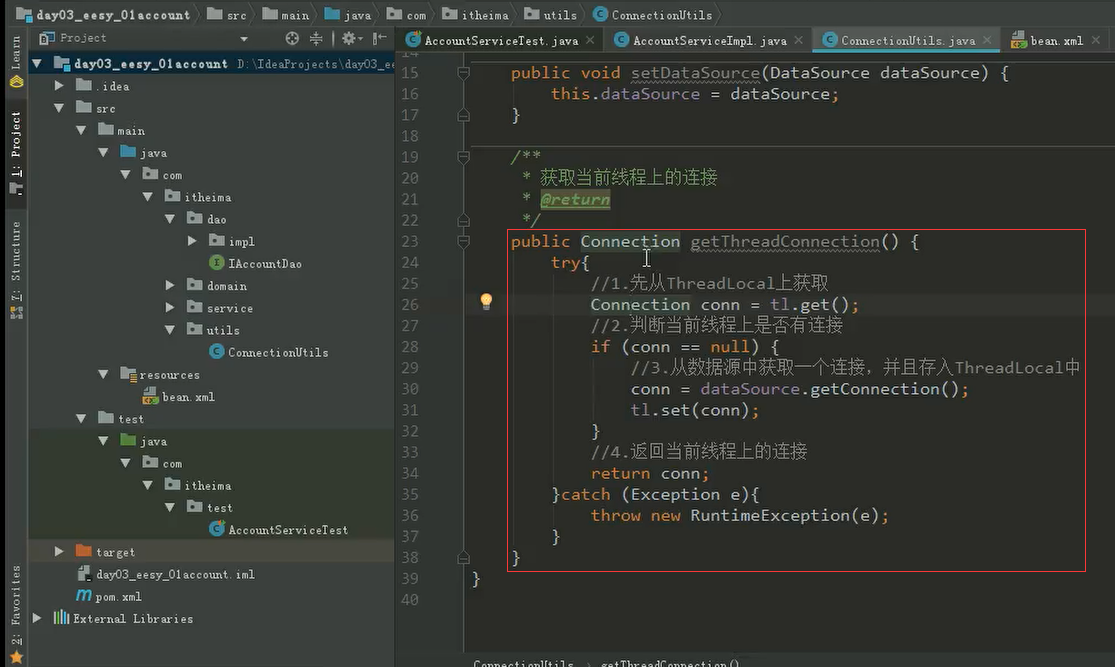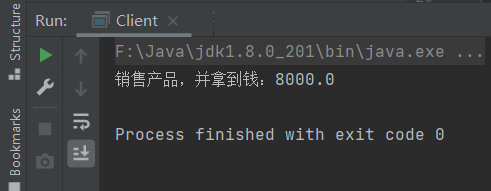- Spring-学习笔记01【Spring框架简介】【day01】
- Spring-学习笔记02【程序间耦合】
- Spring-学习笔记03【Spring的IOC和DI】
- Spring-学习笔记04【Spring的常用注解】【day02】day02资料_dbutils
- Spring-学习笔记05【基于XML的IOC的案例】
- Spring-学习笔记06【Spring的新注解】
- Spring-学习笔记07【银行转账案例】【day03】
- Spring-学习笔记08【面向切面编程AOP】
- Spring-学习笔记09【JdbcTemplate的基本使用】【day04】
- Spring-学习笔记10【Spring事务控制】
目录
05 编写业务层和持久层事务控制代码并配置spring的ioc
01 今日课程内容介绍
今日内容
- 完善我们的account案例
- 分析案例中问题
- 回顾之前讲过的一个技术:动态代理
- 动态代理另一种实现方式
- 解决案例中的问题
- AOP的概念
- spring中的AOP相关术语
- spring中基于XML和注解的AOP配置
02 案例中添加转账方法并演示事务问题
03 分析事务的问题并编写ConnectionUtils

事务控制
04 编写事务管理工具类并分析连接和线程解绑
04.1、ConnectionUtils.java
package com.itheima.utils;
import javax.sql.DataSource;
import java.sql.Connection;
/**
* 连接的工具类,它用于从数据源中获取一个连接,并且实现和线程的绑定。
*/
public class ConnectionUtils {
private ThreadLocal<Connection> tl = new ThreadLocal<Connection>();
private DataSource dataSource;
public void setDataSource(DataSource dataSource) {
this.dataSource = dataSource;
}
/**
* 获取当前线程上的连接
*
* @return
*/
public Connection getThreadConnection() {
try {
//1.先从ThreadLocal上获取
Connection conn = tl.get();
//2.判断当前线程上是否有连接
if (conn == null) {
//3.从数据源中获取一个连接,并且存入ThreadLocal中
conn = dataSource.getConnection();
tl.set(conn);
}
//4.返回当前线程上的连接
return conn;
} catch (Exception e) {
throw new RuntimeException(e);
}
}
/**
* 把连接和线程解绑
*/
public void removeConnection() {
tl.remove();
}
}04.2、TransactionManager.java
package com.itheima.utils;
/**
* 和事务管理相关的工具类,它包含了:开启事务、提交事务、回滚事务和释放连接。
*/
public class TransactionManager {
private ConnectionUtils connectionUtils;
public void setConnectionUtils(ConnectionUtils connectionUtils) {
this.connectionUtils = connectionUtils;
}
/**
* 开启事务
*/
public void beginTransaction() {
try {
connectionUtils.getThreadConnection().setAutoCommit(false);
} catch (Exception e) {
e.printStackTrace();
}
}
/**
* 提交事务
*/
public void commit() {
try {
connectionUtils.getThreadConnection().commit();
} catch (Exception e) {
e.printStackTrace();
}
}
/**
* 回滚事务
*/
public void rollback() {
try {
connectionUtils.getThreadConnection().rollback();
} catch (Exception e) {
e.printStackTrace();
}
}
/**
* 释放连接
*/
public void release() {
try {
connectionUtils.getThreadConnection().close();//还回连接池中
connectionUtils.removeConnection();
} catch (Exception e) {
e.printStackTrace();
}
}
}05 编写业务层和持久层事务控制代码并配置spring的ioc
05.1、bean.xml
<?xml version="1.0" encoding="UTF-8"?>
<beans xmlns="http://www.springframework.org/schema/beans"
xmlns:xsi="http://www.w3.org/2001/XMLSchema-instance"
xsi:schemaLocation="http://www.springframework.org/schema/beans
http://www.springframework.org/schema/beans/spring-beans.xsd">
<!--配置代理的service-->
<bean id="proxyAccountService" factory-bean="beanFactory" factory-method="getAccountService"></bean>
<!--配置beanfactory-->
<bean id="beanFactory" class="com.itheima.factory.BeanFactory">
<!--注入service-->
<property name="accountService" ref="accountService"></property>
<!--注入事务管理器-->
<property name="txManager" ref="txManager"></property>
</bean>
<!--配置Service-->
<bean id="accountService" class="com.itheima.service.impl.AccountServiceImpl">
<!--注入dao-->
<property name="accountDao" ref="accountDao"></property>
</bean>
<!--配置Dao对象-->
<bean id="accountDao" class="com.itheima.dao.impl.AccountDaoImpl">
<!--注入QueryRunner-->
<property name="runner" ref="runner"></property>
<!--注入ConnectionUtils-->
<property name="connectionUtils" ref="connectionUtils"></property>
</bean>
<!--配置QueryRunner-->
<bean id="runner" class="org.apache.commons.dbutils.QueryRunner" scope="prototype"></bean>
<!--配置数据源-->
<bean id="dataSource" class="com.mchange.v2.c3p0.ComboPooledDataSource">
<!--连接数据库的必备信息-->
<property name="driverClass" value="com.mysql.jdbc.Driver"></property>
<property name="jdbcUrl" value="jdbc:mysql://localhost:3306/eesy"></property>
<property name="user" value="root"></property>
<property name="password" value="root"></property>
</bean>
<!--配置Connection的工具类 ConnectionUtils-->
<bean id="connectionUtils" class="com.itheima.utils.ConnectionUtils">
<!--注入数据源-->
<property name="dataSource" ref="dataSource"></property>
</bean>
<!--配置事务管理器-->
<bean id="txManager" class="com.itheima.utils.TransactionManager">
<!--注入ConnectionUtils-->
<property name="connectionUtils" ref="connectionUtils"></property>
</bean>
</beans>06 测试转账并分析案例中的问题
06.1、AccountServiceImpl
package com.itheima.service.impl;
import com.itheima.dao.IAccountDao;
import com.itheima.domain.Account;
import com.itheima.service.IAccountService;
import java.util.List;
/**
* 账户的业务层实现类
* <p>
* 事务控制应该都是在业务层
*/
public class AccountServiceImpl implements IAccountService {
private IAccountDao accountDao;
public void setAccountDao(IAccountDao accountDao) {
this.accountDao = accountDao;
}
@Override
public List<Account> findAllAccount() {
return accountDao.findAllAccount();
}
@Override
public Account findAccountById(Integer accountId) {
return accountDao.findAccountById(accountId);
}
@Override
public void saveAccount(Account account) {
accountDao.saveAccount(account);
}
@Override
public void updateAccount(Account account) {
accountDao.updateAccount(account);
}
@Override
public void deleteAccount(Integer acccountId) {
accountDao.deleteAccount(acccountId);
}
@Override
public void transfer(String sourceName, String targetName, Float money) {
System.out.println("transfer...");
//2.1根据名称查询转出账户
Account source = accountDao.findAccountByName(sourceName);
//2.2根据名称查询转入账户
Account target = accountDao.findAccountByName(targetName);
//2.3转出账户减钱
source.setMoney(source.getMoney() - money);
//2.4转入账户加钱
target.setMoney(target.getMoney() + money);
//2.5更新转出账户
accountDao.updateAccount(source);
// int i=1/0;
//2.6更新转入账户
accountDao.updateAccount(target);
}
}07 代理的分析

代理
08 基于接口的动态代理回顾
?
08.1、IProducer.java
package com.itheima.proxy;
/**
* 对生产厂家要求的接口
*/
public interface IProducer {
/**
* 销售
*
* @param money
*/
public void saleProduct(float money);
/**
* 售后
*
* @param money
*/
public void afterService(float money);
}08.2、Producer.java
package com.itheima.proxy;
/**
* 一个生产者
*/
public class Producer implements IProducer {
/**
* 销售
*
* @param money
*/
public void saleProduct(float money) {
System.out.println("销售产品,并拿到钱:" + money);
}
/**
* 售后
*
* @param money
*/
public void afterService(float money) {
System.out.println("提供售后服务,并拿到钱:" + money);
}
}08.3、Client.java
package com.itheima.proxy;
import java.lang.reflect.InvocationHandler;
import java.lang.reflect.Method;
import java.lang.reflect.Proxy;
/**
* 模拟一个消费者
*/
public class Client {
public static void main(String[] args) {
final Producer producer = new Producer();
/**
* 动态代理:
* 特点:字节码随用随创建,随用随加载
* 作用:不修改源码的基础上对方法增强
* 分类:基于接口的动态代理、基于子类的动态代理
* 基于接口的动态代理:
* 涉及的类:Proxy
* 提供者:JDK官方
* 如何创建代理对象:
* 使用Proxy类中的newProxyInstance方法
* 创建代理对象的要求:
* 被代理类最少实现一个接口,如果没有则不能使用
* newProxyInstance方法的参数:
* ClassLoader:类加载器
* 它是用于加载代理对象字节码的,和被代理对象使用相同的类加载器。固定写法。
* Class[]:字节码数组
* 它是用于让代理对象和被代理对象有相同方法。固定写法。
* InvocationHandler:用于提供增强的代码
* 它是让我们写如何代理。我们一般都是些一个该接口的实现类,通常情况下都是匿名内部类,但不是必须的。
* 此接口的实现类都是谁用谁写。
*/
IProducer proxyProducer = (IProducer) Proxy.newProxyInstance(producer.getClass().getClassLoader(),
producer.getClass().getInterfaces(),
new InvocationHandler() {
/**
* 作用:执行被代理对象的任何接口方法都会经过该方法
* 方法参数的含义
* @param proxy 代理对象的引用
* @param method 当前执行的方法
* @param args 当前执行方法所需的参数
* @return 和被代理对象方法有相同的返回值
* @throws Throwable
*/
@Override
public Object invoke(Object proxy, Method method, Object[] args) throws Throwable {
//提供增强的代码
Object returnValue = null;
//1.获取方法执行的参数
Float money = (Float) args[0];
//2.判断当前方法是不是销售
if ("saleProduct".equals(method.getName())) {
returnValue = method.invoke(producer, money * 0.8f);
}
return returnValue;
}
});
proxyProducer.saleProduct(10000f);
}
}09 基于子类的动态代理
09.1、pom.xml
<?xml version="1.0" encoding="UTF-8"?>
<project xmlns="http://maven.apache.org/POM/4.0.0"
xmlns:xsi="http://www.w3.org/2001/XMLSchema-instance"
xsi:schemaLocation="http://maven.apache.org/POM/4.0.0 http://maven.apache.org/xsd/maven-4.0.0.xsd">
<modelVersion>4.0.0</modelVersion>
<groupId>com.itheima</groupId>
<artifactId>day03_eesy_02proxy</artifactId>
<version>1.0-SNAPSHOT</version>
<packaging>jar</packaging>
<dependencies>
<dependency>
<groupId>cglib</groupId>
<artifactId>cglib</artifactId>
<version>2.1_3</version>
</dependency>
</dependencies>
</project>09.2、Producer.java
package com.itheima.cglib;
/**
* 一个生产者
*/
public class Producer {
/**
* 销售
*
* @param money
*/
public void saleProduct(float money) {
System.out.println("销售产品,并拿到钱:" + money);
}
/**
* 售后
*
* @param money
*/
public void afterService(float money) {
System.out.println("提供售后服务,并拿到钱:" + money);
}
}09.3、Client.java
?
package com.itheima.cglib;
import net.sf.cglib.proxy.Enhancer;
import net.sf.cglib.proxy.MethodInterceptor;
import net.sf.cglib.proxy.MethodProxy;
import java.lang.reflect.Method;
/**
* 模拟一个消费者
*/
public class Client {
public static void main(String[] args) {
final Producer producer = new Producer();
/**
* 动态代理:
* 特点:字节码随用随创建,随用随加载
* 作用:在不修改源码的基础上对方法增强
* 分类:基于接口的动态代理、基于子类的动态代理
* 基于子类的动态代理:
* 涉及的类:Enhancer
* 提供者:第三方cglib库
* 如何创建代理对象:
* 使用Enhancer类中的create方法
* 创建代理对象的要求:
* 被代理类不能是最终类
* create方法的参数:
* Class:字节码
* 它是用于指定被代理对象的字节码。
* Callback:用于提供增强的代码
* 它是让我们写如何代理。我们一般都是些一个该接口的实现类,通常情况下都是匿名内部类,但不是必须的。
* 此接口的实现类都是谁用谁写。
* 我们一般写的都是该接口的子接口实现类:MethodInterceptor
*/
Producer cglibProducer = (Producer) Enhancer.create(producer.getClass(), new MethodInterceptor() {
/**
* 执行被代理对象的任何方法都会经过该方法
* @param proxy
* @param method
* @param args
* 以上三个参数和基于接口的动态代理中invoke方法的参数是一样的
* @param methodProxy:当前执行方法的代理对象
* @return
* @throws Throwable
*/
@Override
public Object intercept(Object proxy, Method method, Object[] args, MethodProxy methodProxy) throws Throwable {
//提供增强的代码
Object returnValue = null;
//1.获取方法执行的参数
Float money = (Float) args[0];
//2.判断当前方法是不是销售
if ("saleProduct".equals(method.getName())) {
returnValue = method.invoke(producer, money * 0.8f);
}
return returnValue;
}
});
cglibProducer.saleProduct(12000f);
}
}10 使用动态代理实现事务控制
?
10.1、BeanFactory.java
package com.itheima.factory;
import com.itheima.service.IAccountService;
import com.itheima.utils.TransactionManager;
import java.lang.reflect.InvocationHandler;
import java.lang.reflect.Method;
import java.lang.reflect.Proxy;
/**
* 用于创建Service的代理对象的工厂
*/
public class BeanFactory {
private IAccountService accountService;
private TransactionManager txManager;
public void setTxManager(TransactionManager txManager) {
this.txManager = txManager;
}
public final void setAccountService(IAccountService accountService) {
this.accountService = accountService;
}
/**
* 获取Service代理对象
*
* @return
*/
public IAccountService getAccountService() {
return (IAccountService) Proxy.newProxyInstance(accountService.getClass().getClassLoader(),
accountService.getClass().getInterfaces(),
new InvocationHandler() {
/**
* 添加事务的支持
*
* @param proxy
* @param method
* @param args
* @return
* @throws Throwable
*/
@Override
public Object invoke(Object proxy, Method method, Object[] args) throws Throwable {
if ("test".equals(method.getName())) {
return method.invoke(accountService, args);
}
Object rtValue = null;
try {
//1.开启事务
txManager.beginTransaction();
//2.执行操作
rtValue = method.invoke(accountService, args);
//3.提交事务
txManager.commit();
//4.返回结果
return rtValue;
} catch (Exception e) {
//5.回滚操作
txManager.rollback();
throw new RuntimeException(e);
} finally {
//6.释放连接
txManager.release();
}
}
});
}
}思人恩德想人好处,这是聚光,光则上扬招财招贵;
天天想人不好嫉妒人抱怨人,这叫招阴,阴则下降招病招祸。





